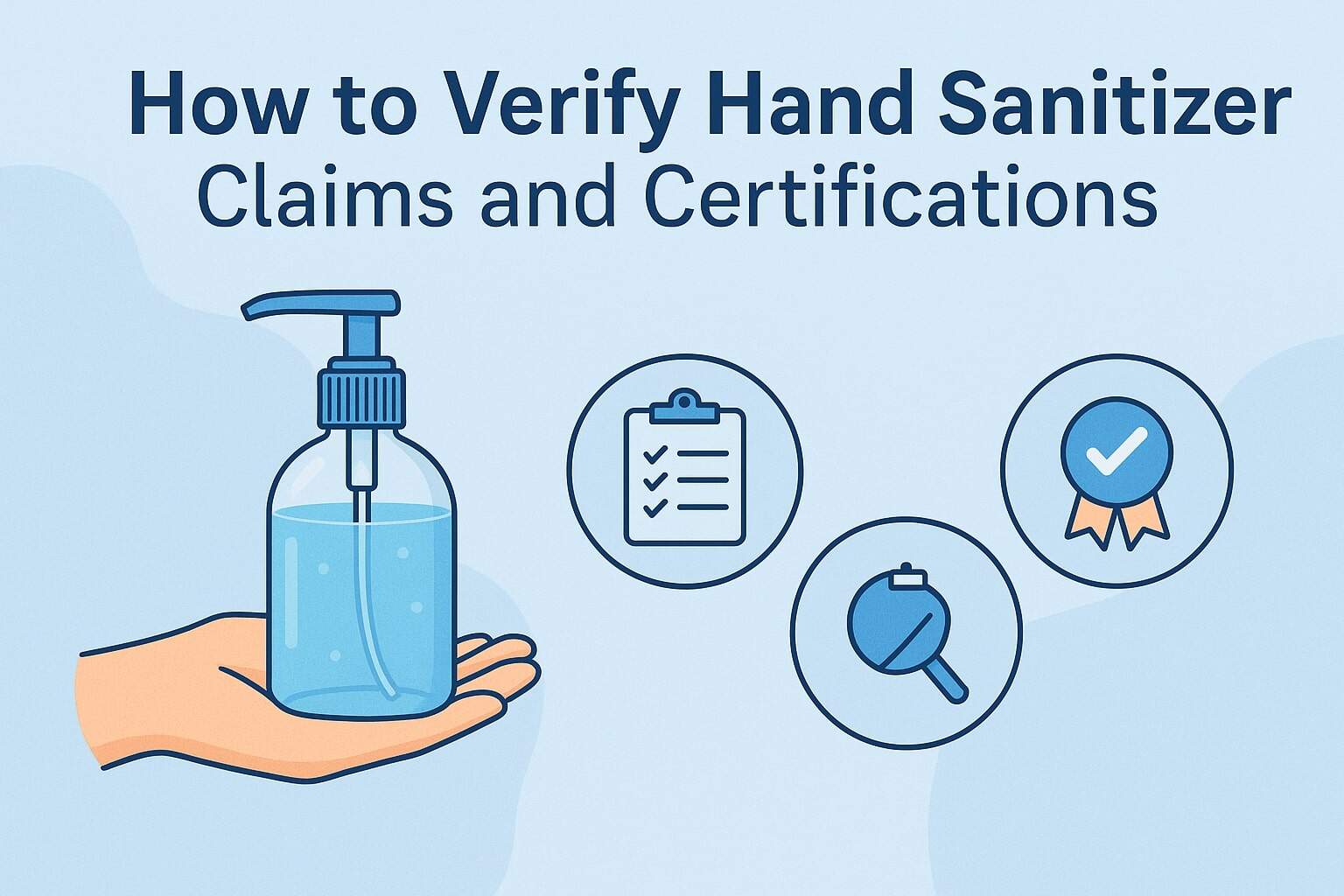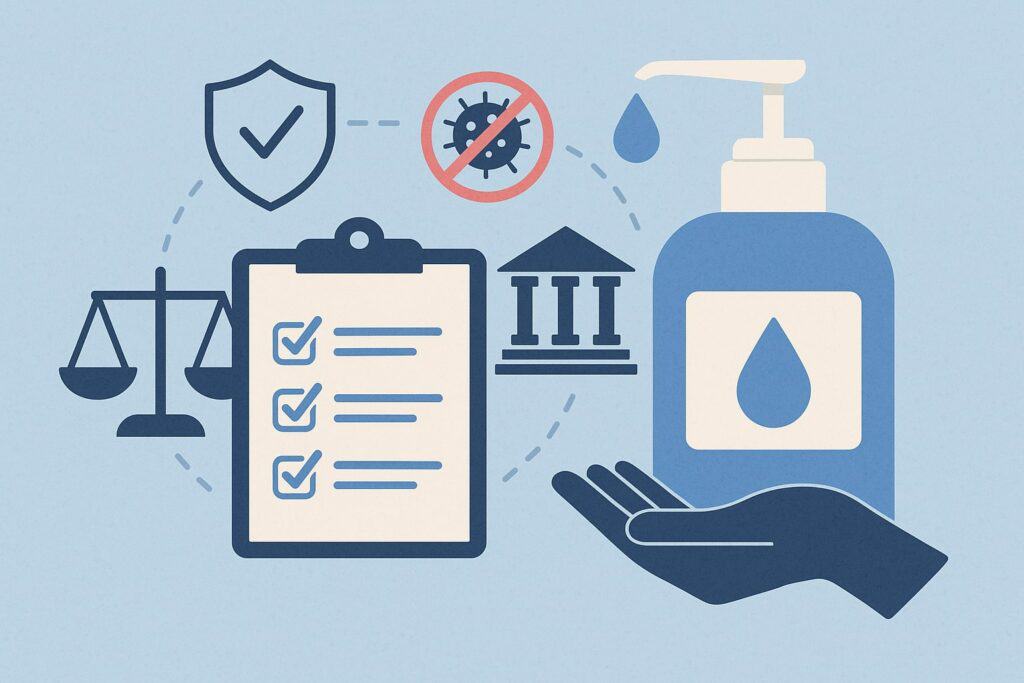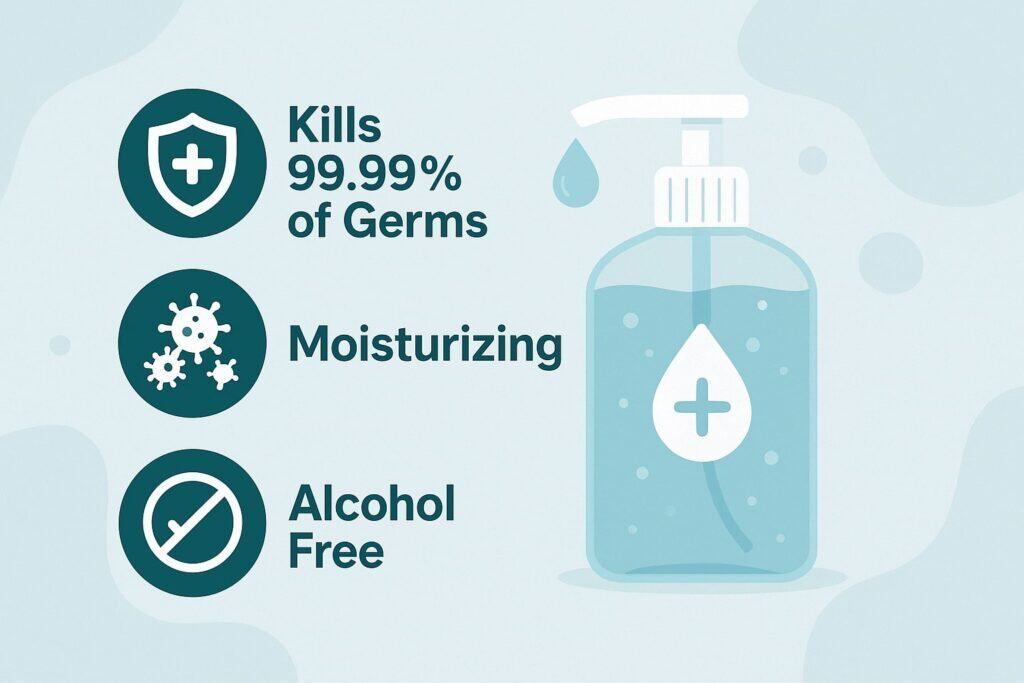
By myhandsanitizershop September 30, 2025
The global health landscape has made hand sanitizers an everyday essential. Yet with their surge in popularity, consumers are faced with thousands of products, each promising protection against germs, viruses, and bacteria.
Not all of these claims are legitimate, and some can even be misleading. Verifying sanitizer claims and certifications is not only vital for consumers but also for businesses, healthcare providers, and regulators who rely on accuracy to ensure public safety.
This article provides a comprehensive, step-by-step guide to understanding what certifications mean, how to check for authenticity, and how to spot false or exaggerated claims. By the end, you will be well-equipped to make informed decisions when purchasing or recommending hand sanitizers.
Understanding Hand Sanitizer Regulations

When evaluating sanitizers, it’s crucial to first understand the regulatory landscape that governs their manufacturing, labeling, and sale. Regulatory oversight ensures that sanitizers meet minimum safety and efficacy standards, protecting consumers from substandard or harmful products.
In the United States, the Food and Drug Administration (FDA) regulates hand sanitizers marketed as over-the-counter (OTC) drugs. This means manufacturers must follow specific monographs and quality guidelines.
For example, sanitizers should contain at least 60% ethanol or 70% isopropyl alcohol to be effective against most harmful microbes. If a label claims “kills 99.99% of germs,” that claim must be backed by scientific evidence submitted to the FDA or peer-reviewed studies.
In addition to the FDA, other bodies such as the World Health Organization (WHO) and the Centers for Disease Control and Prevention (CDC) provide guidelines for sanitizer formulation.
Internationally, organizations like the European Medicines Agency (EMA) and local health authorities enforce similar rules, though the details may vary by country.
Understanding these standards is vital. Many counterfeit or unverified products circulate in markets, often without any compliance or testing.
Some may contain methanol, a toxic alcohol harmful to human health, which the FDA has repeatedly warned against. Without regulatory enforcement, consumers could unknowingly purchase products that are ineffective or even dangerous.
Moreover, manufacturers are required to follow Good Manufacturing Practices (GMPs) to ensure product consistency, safety, and hygiene during production. Certifications such as ISO 22716 (Cosmetics GMP) may also apply in certain regions.
These certifications reflect a company’s compliance with global safety and quality standards, but consumers often overlook them when reading product labels.
In short, regulations are not just bureaucratic hurdles—they exist to protect lives. As a consumer, knowing the basics of these regulations gives you the tools to separate safe, effective sanitizers from unverified or risky ones.
Common Claims Made by Hand Sanitizer Brands

Sanitizer manufacturers often make claims designed to capture attention and instill trust. However, not all claims are meaningful—or even true. Understanding common marketing phrases can help you assess whether a product is worth considering.
A widely seen claim is “Kills 99.99% of germs.” While scientifically possible under controlled conditions, this statement is often misleading. First, it doesn’t specify which germs—are they bacteria, viruses, or fungi?
Second, effectiveness depends on contact time, concentration, and application method. A sanitizer may work in lab conditions but not in real-world scenarios if people apply too little or wipe it off too soon.
Another common claim is “Alcohol-free but equally effective.” Alcohol-free sanitizers often use quaternary ammonium compounds (like benzalkonium chloride). While these may have some antimicrobial activity, the CDC and WHO continue to recommend alcohol-based products as the gold standard.
If you see alcohol-free sanitizers claiming they provide the same level of protection, it’s worth questioning their legitimacy and asking for supporting evidence.
Some brands also market themselves as “natural” or “organic.” While these terms appeal to health-conscious consumers, they do not necessarily mean the sanitizer is safer or more effective.
For example, aloe vera and essential oils may enhance skin feel but do not provide strong germicidal effects on their own. Certifications like USDA Organic might ensure ingredient sourcing quality, but they do not guarantee microbial effectiveness.
You’ll also find sanitizers boasting “hospital-grade” or “clinically tested.” These claims may sound impressive but can be vague. “Hospital-grade” has no strict regulatory definition in many jurisdictions.
Unless linked to an actual certification from a recognized body, it may be little more than a marketing buzzword. Similarly, “clinically tested” does not automatically mean a product was independently reviewed or peer-validated.
Recognizing these claims and questioning them is the first step to becoming a savvy consumer. When evaluating such phrases, always ask:
- Is this claim supported by credible, published data?
- Does it align with recommendations from the FDA, WHO, or CDC?
- Is it verified by independent certification or regulatory approval?
How to Check for Authentic Certifications

Certifications are key markers of credibility, but only if they are genuine. Counterfeiters often forge certification logos to mislead consumers. Knowing how to verify them protects you from falling victim to false claims.
First, always look for FDA registration numbers on products sold in the United States. While not every sanitizer bottle will display this visibly, reputable companies usually provide their NDC (National Drug Code) or establishment registration number. You can cross-check these numbers in the FDA’s online database.
In the European Union, sanitizers should carry a CE mark if classified under biocidal product regulations. Additionally, many will be registered with the European Chemicals Agency (ECHA). Consumers can verify authorization numbers through public databases maintained by the ECHA.
Globally recognized certifications like ISO 22716 or ISO 9001 indicate that a manufacturer follows stringent quality and management systems. Though not always printed on bottles, manufacturers often list them on websites or request documents upon inquiry. If a sanitizer manufacturer refuses to share proof of certification, that should raise a red flag.
Another crucial certification is from the World Health Organization (WHO) for recommended formulations. WHO provides two standard alcohol-based sanitizer recipes used worldwide, particularly in healthcare settings.
Products claiming “WHO-approved formula” should align with these formulations. You can verify this by comparing the ingredient list directly with WHO’s published guidelines.
Additionally, check if products have been third-party tested. Independent laboratories often test sanitizer efficacy against bacteria and viruses. Look for certification marks from credible organizations such as UL (Underwriters Laboratories), NSF International, or other independent auditors.
Finally, be cautious of fake logos. Counterfeiters sometimes print imitation FDA seals or vague “approved” badges. Remember: the FDA does not “approve” hand sanitizers—it regulates them. Any claim of being “FDA approved” is inherently misleading. Instead, look for registration, compliance, or listing confirmation.
By combining label scrutiny, database checks, and direct manufacturer inquiries, you can confidently verify sanitizer certifications and avoid fraudulent products.
Red Flags and Misleading Claims
While many hand sanitizers are safe and effective, others exploit consumer fears and regulatory loopholes. Recognizing red flags can save you from using ineffective or harmful products.
One of the biggest warning signs is the use of vague or exaggerated language. Phrases like “instant immunity,” “guaranteed virus protection,” or “cures COVID-19” are not just misleading but illegal under most regulatory frameworks.
No hand sanitizer can guarantee immunity or cure viral infections. At best, sanitizers reduce microbial presence temporarily.
Another red flag is the absence of ingredient transparency. If a sanitizer does not clearly list its alcohol percentage, active ingredients, or inactive components, it should be avoided.
Genuine products always specify concentrations (e.g., “70% ethyl alcohol”) since these determine effectiveness. Products hiding such details may contain harmful or insufficient ingredients.
Packaging can also reveal much. Low-quality printing, spelling errors, or suspiciously low prices may indicate counterfeit or substandard goods. Counterfeit products often mimic popular brands but with subtle differences in logo design or bottle shape.
Additionally, be cautious of products marketed heavily through social media ads with little to no official presence. Many fraudulent sellers exploit platforms like Instagram and Facebook to push fake sanitizers, disappearing once complaints arise. Always buy from reputable pharmacies, recognized retailers, or directly from manufacturer websites.
Finally, check for recall warnings. The FDA frequently publishes lists of sanitizers found to contain methanol or substandard alcohol levels. Consumers can easily cross-check brand names and batch numbers on these lists. Ignoring such warnings could lead to using dangerous products with toxic side effects.
By staying alert to these red flags, consumers can protect themselves from ineffective or harmful sanitizers. Vigilance is especially critical during health crises when demand surges and counterfeiters exploit panic buying.
Best Practices for Consumers
Even with legitimate certifications and claims, how consumers use hand sanitizers determines their effectiveness. Following best practices ensures maximum safety and hygiene.
Start with the right concentration. Choose sanitizers with at least 60% ethanol or 70% isopropyl alcohol. Anything lower may not be effective against many harmful microbes. For alcohol-free alternatives, ensure they are registered and validated by credible health authorities.
When applying sanitizer, use an adequate amount—usually about a dime-sized portion. Rub thoroughly across palms, fingers, nails, and the backs of hands for at least 20 seconds. Stopping too early reduces effectiveness, as alcohol needs time to denature microbial proteins.
Storage also matters. Keep sanitizers tightly closed and away from direct sunlight or heat, as alcohol can evaporate or degrade. Check expiration dates before use. Expired sanitizers may have reduced alcohol concentration, rendering them less effective.
For parents, it’s essential to monitor children using sanitizers. Ingesting even small amounts of alcohol-based sanitizer can be toxic. Always supervise use and encourage soap-and-water handwashing as the primary method, using sanitizer only when water isn’t available.
Consumers should also practice situational awareness. Sanitizers are most effective when hands are not visibly dirty or greasy. If hands are soiled, wash with soap and water first. Sanitizers are an adjunct, not a replacement, for proper hygiene.
Finally, consider buying from reputable brands that offer transparency and customer support. Companies willing to share batch testing reports, ingredient sourcing, and certification documents demonstrate accountability. Supporting such brands ensures long-term consumer trust and safety.
FAQs
Q1. Can a hand sanitizer really kill 99.99% of germs?
Answer: This claim is common and technically achievable under laboratory conditions. However, in real-world use, the actual effectiveness may vary. Factors like how much product you apply, how long you rub your hands, and whether your hands are visibly dirty all influence results.
A sanitizer with at least 60% alcohol concentration has been proven effective against many common germs, but no sanitizer can guarantee 100% elimination of all pathogens.
It’s also important to note that “germs” is a broad term. While alcohol-based sanitizers work well against many bacteria and viruses, they may not kill certain hardy spores or parasites. This is why health organizations emphasize sanitizers as a convenient tool—not a substitute—for proper handwashing with soap and water when available.
Q2. Are alcohol-free sanitizers effective?
Answer: Alcohol-free sanitizers often contain benzalkonium chloride or similar compounds. While these may have some antimicrobial effects, the CDC and WHO do not recommend them as the primary choice. Alcohol remains the gold standard due to its proven ability to quickly denature proteins and inactivate viruses.
That said, alcohol-free products may still be useful in certain contexts, such as for people with skin sensitivities or for use in schools where ingestion risks exist.
However, their effectiveness is generally lower and may not cover the full spectrum of pathogens that alcohol-based sanitizers do. Always look for official certifications or approvals before relying on alcohol-free alternatives.
Q3. How can I tell if a sanitizer certification is fake?
Answer: Fake certifications are unfortunately common. A simple test is to check whether the product claims to be “FDA approved.” The FDA does not approve hand sanitizers—it regulates them. Instead, look for registration numbers or listing confirmations. You can verify these through the FDA’s official online databases.
Another tip is to carefully inspect logos or seals. Counterfeiters often use poorly designed icons or unauthorized symbols. Cross-reference the certification body (such as ISO or WHO) to confirm whether that brand appears in their public registries. If you can’t find the manufacturer’s name or product listed, the certification is likely fake.
Q4. What should I do if I bought a recalled sanitizer?
Answer: If you discover that your sanitizer is on an FDA or other health agency’s recall list, stop using it immediately. Unsafe products may contain toxic substances like methanol, which can cause nausea, headaches, or even blindness when absorbed through the skin or ingested accidentally.
Dispose of the sanitizer safely, following local hazardous waste disposal guidelines. Do not pour it down the sink or toilet, as this can harm the environment. Contact the manufacturer or retailer about potential refunds or replacements. Keeping receipts or product photos can help when reporting issues to health authorities.
Q5. Why are certifications important if I trust the brand?
Answer: While brand trust is valuable, certifications provide objective verification. Even reputable companies must prove that their products meet regulatory standards. Certifications from independent or government agencies serve as external checks, ensuring that consumers aren’t relying solely on marketing claims.
Without certifications, even trusted brands could release inconsistent batches or make exaggerated claims. Certifications also protect consumers legally, as regulators can hold companies accountable for false advertising. By prioritizing certified products, you protect both your health and your consumer rights.
Conclusion
Hand sanitizers are more than just convenience products—they are frontline tools in global health defense. However, their effectiveness depends not only on proper use but also on the legitimacy of their claims and certifications.
By learning to identify genuine certifications, questioning vague marketing language, and following best practices, consumers can safeguard themselves and their families from both germs and fraudulent products.
Whether you are a healthcare professional, business owner, or everyday consumer, the responsibility lies in making informed decisions. Certifications exist to protect you, but only if you take the time to verify them. In a world filled with choices, knowledge remains your most powerful sanitizer.